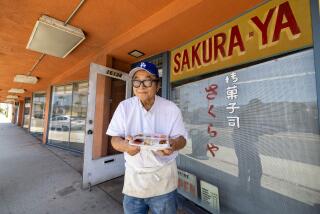Japan Mob Muddies Real Estate Loan Crisis
OSAKA, Japan — A white Mercedes-Benz with tinted glass, a trademark vehicle for yakuza, Japan’s mobsters, waited in front of the 11-story luxury apartment, engine running, a glamorous young woman at the wheel and a tough-looking man by her side.
Inside the entryway, the man’s voice on the intercom was rich with self-confidence when a visitor asked if his unit was occupied by the Bukyokai, a subgroup of Japan’s biggest yakuza gang.
“You’ve done your homework well,” he said with a laugh.
But when asked about Sueno Kosan, the prominent Osaka real estate firm that owns the garish building, the man hung up.
Kenichi Sueno, president of the essentially bankrupt company, can’t avoid questions quite so easily. Partly because of his gangster tenants, Sueno and his company are at the center of a widening controversy--sparked by the current bank loan crisis--over the role of yakuza in Japan’s banking system.
Under investigation for tax evasion, Sueno is so widely suspected of mob affiliation that he felt compelled to call a January news conference to deny it: “I am not a yakuza,” he declared.
After years of ignoring the problem and wishing it would go away, Japan is finally beginning to examine the sometimes-cooperative, sometimes-violent, always-murky relationship among yakuza, real estate developers and banks.
The belated self-examination was triggered by the dangerous financial mess caused by banks making as much as $800 billion in bad loans--loans backed by over-priced real estate during the “bubble economy” fervor of the late 1980s. When land prices collapsed, the collateral’s worth dropped to less than half the amount of the loans.
For reasons that lie in the nature of Japan’s rapid post-World War II land development, many of those bad loans are to firms with yakuza ties. No one knows for sure what the percentage is, but estimates range as high as 80%.
Now a fierce controversy has erupted over how to deal with the loan mess, which some analysts say totals twice the government’s $400-billion estimate.
Critics argue that if the cleanup is mishandled, the yakuza--who a decade ago lived mainly on extortion, gambling, prostitution and the sale of stimulants--will become entrenched in the legitimate economy.
Hitoshi Yamada, an attorney who is spearheading efforts by the Japan Bar Assn. to fight organized crime, said that if the banks cave in and write off their losses, abandoning the properties, clear title on 50% to 80% of the assets put up as collateral for bad loans will pass to corporations controlled or influenced by yakuza, who sit on the boards of many such firms.
Thus, Yamada said, unless the banks press court action to recover all the property--a task that under current law is difficult and even dangerous for banks to attempt on their own--the economic power of the yakuza “could become 10 times what it is now.”
Role Acknowledged
The Finance Ministry has acknowledged the yakuza’s role in the banking system’s problems, and in November proposed a new agency to combat them.
The proposed agency would be able to confiscate and sell to “clean” buyers collateral for nonperforming loans.
But this is part of a cleanup plan that would require about $12 billion in public funds, a prospect that outrages many citizens.
Yakuza date to feudal times in Japan, when they included the bakuto, or professional gamblers, and the tekiya, or racketeer organizations of dishonest peddlers and street entertainers.
This history gave rise to a romantic image of yakuza as wandering gamblers who helped the weak and punished the strong. After World War II, a popular genre of yakuza films perpetuated the Robin Hood theme.
But the postwar yakuza became decidedly unromantic. They absorbed juvenile delinquents and entered a wide range of criminal activities, consolidating into three dominant crime families: the Yamaguchigumi, with an estimated 30,000 members; the Sumiyoshikai, with 10,000; and the Inagawakai, with 8,000.
Adding in nonaffiliated groups, police estimate the total number of yakuza at 80,000.
The roots of the gangsters’ move into big-time business, and their pivotal role in the banking crisis, largely result from their ties to jiageya, or land consolidators--people who assemble tiny adjacent plots into pieces big enough for modern developments.
Throughout Japan’s recent economic development, yakuza were called in when recalcitrant tenants or homeowners--protected by strong tenants’ rights laws and weak powers of eminent domain--stood in the way of commercial projects. Illegal coercion was often the answer. Even government agencies indirectly used them on occasion to clear the way for highways or other projects.
Land consolidators “are notorious in this society, but without them cities wouldn’t be able to develop,” Ryuma Suzuki, 62, a top Sumiyoshikai leader, said in explaining why the jiageya’s rough tactics have been tolerated.
“They are the front soldiers for the big companies, and play the ‘bad guys’ role for them. The big corporations don’t want to put their hands into the dirt. They don’t want to get involved in trouble. They wait for other companies to do the dirty business first.”
Yakuza tactics include verbal harassment, veiled threats and techniques such as fouling properties with manure, “accidentally” crashing into buildings with dump trucks and arson.
The ‘Bubble’ Years
This became especially lucrative during the “bubble” years. Gangsters moved into the field in a big way, establishing ever-tighter relations with jiageya, real estate firms, construction companies and even banks. Sometimes they became jiageya.
And when extra money was needed to offer a bigger carrot as well as a stick to holdouts, jiageya sometimes turned to yakuza loan sharks for the funds. This further boosted the gangs’ “equity” in real estate development.
The targets of coercion are people like retired auto parts factory worker Hideo Matsumoto, 63.
Last year, he said, men came to his rented home in a working-class area of Osaka. They declared that they represented the property’s new owner and demanded that he move out. He refused.
But his next-door neighbor, with whom he shared a wall, quickly accepted payment to move. The land development firm sent a “caretaker” to live there, and soon the “caretaker” was inviting in “yakuza-type” friends.
“They drank until late, made noise and kicked the walls in the middle of the night,” Matsumoto said. “They wandered around on the street until 2 a.m. or 3 a.m. and shouted, ‘Come out you paupers! You should go to hell!’ ”
Some of the neighbors called the police. “But the police were very reluctant to come,” he recalled. “They said, ‘It must be a fight between landlords and tenants. That’s a civil matter, so you should find a good solution on your own.’ ”
So far, Matsumoto has been relatively lucky. Twelve families on this 19-home parcel are still resisting with him. But the attached home has already been torn down, and the owner has failed to put up promised supports, leaving Matsumoto’s home unsafe. The neighborhood, where jiageya have targeted many parcels, has had two suspicious fires recently, including one in which a resident died.
Some analysts--even ones who despise the yakuza--concede that their services as land consolidators played a useful, if unsavory, role in the modernization of Japan.
But Japan is paying the price for years of looking away while gangsters and unscrupulous developers preyed on people like Matsumoto.
By the time the speculative “bubble” collapsed five years ago, a community of interests had emerged between criminals and legitimate businesses.
Some firms hired gangsters as advisors or put them on their boards, the better to deal with other yakuza confronted in the course of business. Some used gangster expertise in false accounting, money laundering or shady securities deals. Sometimes firms were drawn into such relationships after having trouble repaying loans from yakuza.
Bankers even approached yakuza organizations and encouraged them to borrow money, while securities firms urged them to buy stock, according to Raisuke Miyawaki, former head of the anti-yakuza division of the National Police Agency who now is an independent business consultant.
As real estate developers, bankers and yakuza worked together, gangsters collected evidence of their partners’ misdeeds that can be used for extortion or to back up refusals by yakuza-controlled companies to repay loans, Miyawaki said.
“Yakuza feel psychologically superior to banks, because both the banks and the housing finance companies lacked responsibility and morals,” Miyawaki said. “The yakuza were astounded to find out that the banks were more outrageous than themselves.”
Bank Practices Cited
Yukio Yamanouchi, an Osaka attorney who has frequently represented Yamaguchigumi defendants in criminal cases, noted that “during the ‘bubble,’ banks just kept loaning money as long as the borrowers had land.”
“They were like kashimoto, the yakuza who loan money to customers at gambling halls,” he said. “In that kind of situation, the kashimoto get more blame than the gamblers. It could be said that in the ‘bubble era,’ 100 million people were gamblers, and in this game they used land as the tool for gambling, and banks played the role of kashimoto. I think they are the ones who should be blamed.”
Meanwhile, yakuza have learned to play both sides of the fence: In addition to their talents at driving people from their homes, they can be extremely useful in helping financially troubled owners hang on to property. Since eviction of tenants--even gangsters--is so difficult and time-consuming in Japan, yakuza have the power to make foreclosure highly unattractive to financial institutions.
Yakuza leader Suzuki explained how it works:
“When banks try to foreclose on collateral, the yakuza are the ones who prevent them from doing so. In most cases, they’re asked by the building owner to move in rent-free, because nobody will try to buy it in an auction if yakuza are living in some of the rooms. If the auction is postponed, then the owner can continue to earn money from rent paid by the other tenants. Those who owe money are making use of the yakuza.”
Confronting the gangsters can be dangerous.
In a 1994 case widely presumed to be tied to efforts at bad-loan collection, Kazufumi Hatanaka, manager of Sumitomo Bank’s branch in the city of Nagoya, was murdered execution-style, shot in the head outside the door of his 10th-floor apartment.
The year before, Tomosaburo Koyama, vice president in charge of problem loans for Hanwa Bank, was killed in what police said was the work of a hit man.
Fear thus adds to the hesitation bankers would normally feel about foreclosing on nonperforming loans, since the value of real estate collateral is so much less than the value of the loans. For many bank executives, it is easier to pretend that someday the loans might be repaid rather than admit to huge losses.
Meanwhile, Sueno goes about his business, looking more like an ordinary businessman than someone associated with the yakuza, who are famed for elaborate tattoos and shortened fingers, chopped off at the tip in acts of attrition for mistakes made within gang society.
Sueno claims that his only link to the yakuza is as a victim of gangster tenants who will not move out.
“It is said that I’m a gangster,” Sueno said last month. “But do I look like one?”
Chiaki Kitada and Megumi Shimizu of The Times’ Tokyo Bureau contributed to this report.
More to Read
Inside the business of entertainment
The Wide Shot brings you news, analysis and insights on everything from streaming wars to production — and what it all means for the future.
You may occasionally receive promotional content from the Los Angeles Times.










